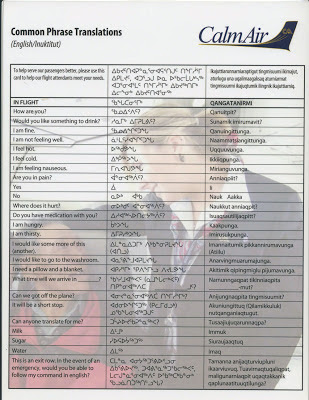 |
| Jim Halfpenny at the Churchill Northern Studies Centre, November 2012 |
In this year's series I'm going to post on topics that weren't covered, or weren't thoroughly covered, either by blogging, experience, or instruction, last year. First up: one of Canada's workhorse regional air transportation companies, Calm Air, and the reasons for loving to fly. Canada's regional transportation needs present very different issues than those of the United States. Unlike ours, which is more or less evenly distributed, Canada's population density drops off strikingly the farther north you go (the red star on Hudson Bay is Churchill):
 |
| View map source here |
The completely roadless remoteness presents many challenges for delivering goods and services, for conducting business (including extractive industries and tourism), for sustaining household economies, for education, communication, and perhaps above all else, for routine and emergency medical care. The distances are significant. From Winnipeg in lower Manitoba to Churchill, is 850 miles. For those who live beyond, it can be nearly twice as far by air, and only a few locations (including Churchill) are served by rail. Regional air services are the workhorses and saviors for the inhabitants of those tiny green dots.
Women living in towns as "large" as Churchill (the year-round population is about 800) and as small as a couple of hundred people, are flown to the nearest town or city to give birth, even when no problems are anticipated. People who suffer accidents - of which there must be plenty in this land of heavy physical labor - and acute or chronic illnesses also must be air lifted to towns with trauma centers and full medical services. On our leg from Winnipeg to Churchill was a very young woman with her baby girl of just 48 hours, flyinghome from Winnipeg to Arviat via Churchill. Young mother was by herself: no mother or grandmother, no sister, no baby father, no money provided for anyone to accompany her to the bright lights of a major urban labor and delivery room and back home with her tiny infant. She was cheerful and sweetly confident, and her baby was content throughout the 2 hour 15 minute flight to Churchill.
Our flight left before dawn on a darkly overcast, slightly rainy Winnipeg morning. Once checked in, our group of 19, the young mother and child, and a sprinkling of other travelers were quickly boarded on the day's first flight out on Calm Air's model ATR 42 300 turboprop, with seating for 42 passengers that is much more comfortable than your average Boeing 737. This is an aircraft with the wing at the top of the body ("high wing" design), which means good views for most passengers. Since the major joy of flying for me is the prospect of views, I was delighted. The clouds weren't so thick that we weren't above them almost immediately, so I sat back and watched the delicate pale blue of the sky lighten ever so gently.
Calm Air
lived up to its name as were served a little box breakfast. When was
the last time you were served reasonable food on a flight that short?
When was the last time your seat pocket provided a handy written (Roman
letters and Canadian Aboriginal Syllabic) and transliterated translation
of English to Inuktituk (the language of the Inuit) of phrases commonly needed by the traveler?
Then suddenly it was dawn no more: the sun had breached the clouds below, revealing spots of dirt on the window and the glorious deep blue skies of the day. But soon we were to lose sight of the sun once again as we, calmly of course, set down on the 9,200 foot tarmac of Churchill's little airport. Read the interesting history of this little airport at Transport Canada's website. Suffice it to say, the extremely long runway is a U.S. Department of Defense strategic legacy.
Last year we arrived in a wet windstorm, with very little visibility from the air. But this year, when we popped down below the cloud deck, I got my first shots of the tundra with a bit of boreal forest for relief of the otherwise watery, nearly flat, and featureless monochromatic landscape:
Alas, the weather was not so sparklingly bright on the ground either, but here's a view of our commodious chariot from the outside.
And Churchill's cheery little terminal
Our departure a week later finally afforded more substantially interesting views. In this image, the edge of Hudson Bay, with its fast-developing shore ice, and the Churchill River, which already had significant ice formation, are clearly visible:
In this more inland view, it's easy to see how wide and braided the Churchill River is:
This shot of what has to be called "Heart Lake" was taken some distance west and south of Churchill, as is evident by the taiga (thick forestation), but still in very remote territory nonetheless:
I look at this and think, what goes on down there? Do people occupy these empty spaces, with all their features and beauty evident from above? Has someone mapped and studied every one of those little ponds and pools and lakes? Is it a great place to fish in the summer? Is it protected land? Or will it be despoiled by extractive activities, will it have disappeared the next time I fly over? Paying attention to what's below the aircraft can add immeasurably to one's conception of land forms, impressions of population density (none, in the case of northern Manitoba), and man's use and abuse of the earth. And it can awe one's spirit in its with majesty and beauty. Oh, and how I do love powerfully noisy machines (turn on your sound for the best effect)!
Stay Calm and Carry On.
Go to Part II: The Dogs of Churchill








DSC_0620.jpg)
DSC_0623.jpg)



I am looking forward to your next post!
ReplyDelete